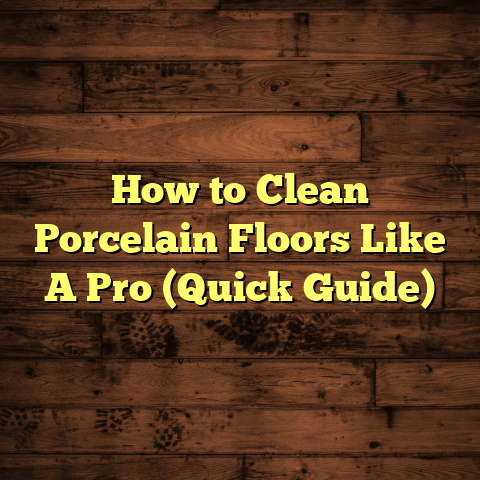Can You Make Your Own Wood Flooring? [DIY Guide]
Aesthetics of Wood Flooring
There’s something about the warmth and character that natural wood brings to a space. I remember walking into a friend’s home with rich oak floors, where every grain told a story. It instantly transformed the atmosphere, making it feel inviting and cozy.In my career as a flooring contractor, I’ve come across countless styles, colors, and finishes of wood flooring. Each choice significantly impacts the room’s overall look and feel. Whether you prefer the rustic charm of reclaimed barn wood or the sleek lines of modern engineered hardwood, the right flooring can enhance your home’s aesthetic.
As I began this journey to create my own wood flooring, I was inspired by the idea of customizing every detail—from wood type to finish—ensuring that it would reflect my personal style. A key part of this process was understanding how different woods interact with light and color in a space. Choosing the right species became a critical decision.
Choosing the Right Wood
Selecting the ideal wood species for flooring is foundational to creating something beautiful and functional. In my case, I opted for oak due to its widespread availability, durability, and timeless appeal. Oak flooring can withstand heavy foot traffic, making it perfect for households with kids or pets.
Aside from oak, other popular options include:
- Maple: Known for its hardness and fine grain.
- Hickory: Offers a unique grain pattern and is very durable.
- Cherry: Known for its rich color that deepens over time.
When choosing, consider not only aesthetics but also practicality. For instance, softer woods like pine can dent easily and may not be ideal for high-traffic areas.
Sourcing Materials
Finding quality materials was one of my first tasks. While new lumber is readily available at many home improvement stores, I wanted something with character—hence my choice of reclaimed wood. I scoured local lumberyards specializing in salvaged materials.
Reclaimed wood often comes from old barns or factories, adding history and uniqueness to your flooring. However, sourcing it can be time-consuming. I found a great local supplier who had a variety of options, which made the process enjoyable. The price for reclaimed oak varied between $3 to $6 per square foot, depending on quality and finish.
Tools and Equipment
Before starting any project, having the right tools is essential. Here’s a list of the tools I used throughout my flooring project:
- Table Saw: For cutting planks to width.
- Jointer: To ensure edges are straight and flat.
- Planer: To achieve consistent thickness across all planks.
- Sander: For smooth finishing.
- Miter Saw: Great for making precise angled cuts.
- Nail Gun: Essential for fastening down your flooring efficiently.
Each tool plays a critical role in the process. For example, my jointer helped me create perfectly straight edges, which were crucial for tight seams between planks. Investing in good-quality tools made a significant difference in the ease and quality of my work.
Preparing the Wood
Once I gathered my materials and tools, it was time to prepare the wood.
Inspecting for Defects
First, I sorted through my reclaimed wood pieces, carefully inspecting them for defects such as knots or large cracks. While some imperfections can enhance character, others can compromise structural integrity. I set aside any pieces that were too damaged for use.
Cutting to Length
I decided on lengths ranging from 3 to 5 feet for my planks. This length gives a nice visual flow without being too long or cumbersome to work with. Using my table saw, I methodically cut each piece down to size.
Thickness Consistency
The next step involved ensuring uniform thickness across all planks. I utilized my planer for this task, setting it to achieve a thickness of about ¾ inch—standard for hardwood flooring. This consistency ensures that all planks fit together seamlessly during installation.
Jointing and Sanding
With my pieces cut and planed, jointing came next. This process ensures that each edge is straight so that they fit tightly together.
Using the Jointer
I aligned each plank with precision on my jointer, removing any imperfections along the edges. The process was straightforward but required patience and focus. After jointing, I ran each plank through my sander using progressively finer grits to achieve a smooth surface.
The Importance of Sanding
Sanding is arguably one of the most crucial steps in preparing wood flooring. It not only helps achieve a smooth finish but also allows the stain or finish to adhere better later on. I spent more hours sanding than I initially expected, but the results were worth it—my planks felt velvety to the touch.
Finishing Processes
After sanding, I reached one of the most exciting parts: finishing the wood.
Choosing a Finish
I chose a polyurethane finish for its durability and ease of maintenance. There are various finishing options out there:
- Oil-Based Polyurethane: Offers a warm glow but takes longer to dry.
- Water-Based Polyurethane: Dries quickly and has less odor but may not provide as rich a finish.
- Natural Oils: Such as tung oil or linseed oil; these penetrate the wood but require more frequent reapplication.
I applied three coats of polyurethane to ensure maximum protection against scratches and moisture. The finish dramatically changed the aesthetic of the wood, enhancing its natural beauty.
Installation Challenges
With all planks prepped and finished, it was time for installation—a phase where several challenges awaited me.
Preparing the Subfloor
Before laying down any boards, I needed to ensure that my subfloor was level. Uneven subfloors can lead to squeaks and gaps in your finished floor. I used a leveling compound in areas where dips were present; this added an extra layer of work but was necessary for a successful installation.
Installing the Planks
For installation, I chose a nail-down method due to its reliability with solid hardwood floors.
Choosing Adhesives and Fasteners
Using quality adhesive specially designed for hardwood floors ensured that my planks would stay securely in place over time. I also utilized flooring nails that were specifically designed for nail-down installations—these help hold everything together firmly while minimizing damage to the wood.
The Installation Process
I started from one corner of the room, laying down my first plank carefully aligned against the wall. Using a nail gun made fastening quick and efficient—I could easily drive nails into the tongue of each plank without damaging its surface.
As I worked through the room, maintaining straight lines and ensuring each plank fit snugly against one another became crucial tasks. This process took several days due to its meticulous nature but gradually transformed my space into something beautiful.
Dealing with Issues
Throughout installation, I encountered several unexpected issues:
- Gaps Between Planks: In certain areas where humidity fluctuated, slight gaps appeared between some planks after installation. To address this, I used wood filler that matched my stain color—this helped blend imperfections.
- Uneven Edges: A couple of planks didn’t sit flush against one another due to slight variations in thickness that slipped through during preparation. A quick pass with the sander helped rectify this issue before finalizing everything.
- Accurate Measurements: Keeping track of measurements was vital as well; miscalculating even an inch could lead to major issues down the line.
Final Touches
After all planks were installed, it was time for final touches.
Cleaning Up
I took time to thoroughly clean the new floor—sweeping up any dust from sanding and installation debris helped ensure that everything looked pristine.
Maintenance Tips
Caring for your new floor involves some simple steps:
- Regular Cleaning: Sweep or vacuum regularly to remove dirt and debris.
- Use Appropriate Cleaners: Invest in cleaners specifically formulated for hardwood floors; avoid harsh chemicals that can damage finishes.
- Humidity Control: Maintaining appropriate indoor humidity levels can prevent warping or gaps from forming over time.
- Area Rugs: Using rugs in high traffic areas can help protect your flooring from wear and tear.
The Satisfaction of Success
Stepping onto my completed floor felt surreal; it was immensely rewarding seeing all my hard work come together beautifully. The rich oak color complemented my home’s decor perfectly while adding warmth and character.
Reflecting on this experience reminds me of how much I learned—not just about flooring but also about patience and craftsmanship.
Comparing DIY vs. Store-Bought Options
In considering whether to make your own flooring versus purchasing pre-finished products, several factors come into play:
- Customization: DIY allows you complete control over every detail—from wood species to finish—ensuring it fits your style perfectly.
- Cost: While making your own may save money if you have access to materials/tools, purchasing pre-finished options can be more straightforward without requiring much labor.
- Time Investment: DIY projects require considerable time and effort; if you’re pressed for time or lack experience, buying ready-made may be easier.
- Quality Control: Creating your own floors means you can personally oversee quality at every step; however, well-made pre-finished products offer reliability from reputable manufacturers.
Conclusion
Creating your own wood flooring is an enriching journey filled with creativity and personal expression. While challenges undoubtedly arise along the way, each step offers valuable lessons that contribute to both skill development and satisfaction.
By choosing materials carefully, preparing thoroughly, and embracing your unique style throughout the process, you can achieve stunning results that enhance your home’s aesthetic appeal for years to come.
So now that you’ve read through this detailed account of my experience—are you feeling inspired to try making your own wood flooring? With dedication and passion, you can craft something truly special!



![Hardwood Floors Over Crawl Space? [Avoid Costly Mistakes]](https://floortally.com/wp-content/uploads/2025/01/Hardwood-Floors-Over-Crawl-Space-Avoid-Costly-Mistakes.png)
![Can Epoxy Floors Be Waterproofed? [Critical Guide]](https://floortally.com/wp-content/uploads/2025/01/Waterproofing-Epoxy-Floors-Is-It-Possible.png)

![LVP Flooring: What Does it Stand For? [Must Know Now]](https://floortally.com/wp-content/uploads/2025/01/What-Does-Lvp-Flooring-Stand-For.png)